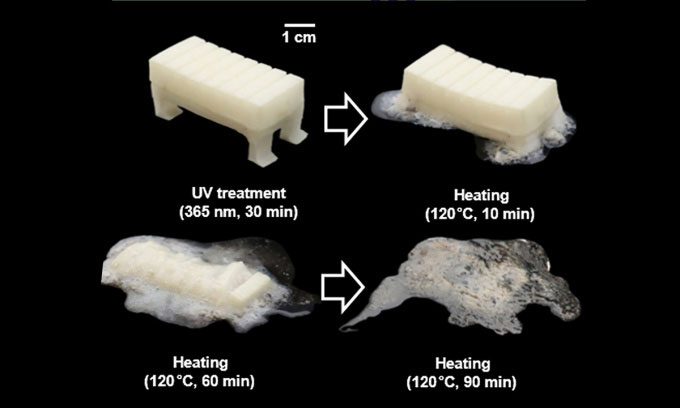In a recent experiment, a 3cm-long robot made of silicone plastic mixed with compounds successfully completed reconnaissance missions, reported the results, and self-destructed.
With the goal of creating robots capable of controlling their own lifecycle, a research team from South Korea has developed small, soft devices that can melt into a puddle, Science Alert reported on September 10. The new study was published in the journal Science Advances.

The robot decomposes at 120 degrees Celsius after exposure to ultraviolet light. (Image: Science Advances)
“We simulated a death in a lifecycle that the robot can terminate itself,” said Min-Ha Oh, an engineer at Seoul National University. “The ‘death’ is triggered when the ultraviolet LEDs inside the robot destabilize its chemical components. This process takes about an hour.
The body of the 3cm robot is made from diphenyliodonium hexafluorophosphate mixed with silicone plastic. These materials allow the robot to be sturdy yet flexible enough to crawl across surfaces like a four-legged caterpillar. The robot operates using pneumatic power.
Unlike traditional robots with limited degrees of freedom, soft robots demonstrate good adaptability and can perform complex movements, such as handling fragile objects or adapting to unstable environments, according to the research team. This capability can be beneficial for tasks such as delivering medication to specific targets in hard-to-reach areas of the human body, disaster zones, or deep underwater.
Oh and her colleagues tested the new robot by assigning it a reconnaissance mission. Equipped with ultraviolet, temperature, and deformation sensors, the small robot successfully approached a gun, measured its temperature, and then retreated to a safe position to report the results and activate the self-destruction process.
Exposure to ultraviolet light causes diphenyliodonium hexafluorophosphate to convert into fluoride, weakening the entire structure to the point where high temperatures will cause it to melt. The robot disintegrates completely, leaving only a puddle of viscous liquid made of silicone and degraded thin-film electronics.
However, this puddle contains fluoride ions that can be toxic, so the research team has added calcium chloride to help neutralize it. Experts noted that further research is needed to improve the environmental impact of the viscous liquid.




















































